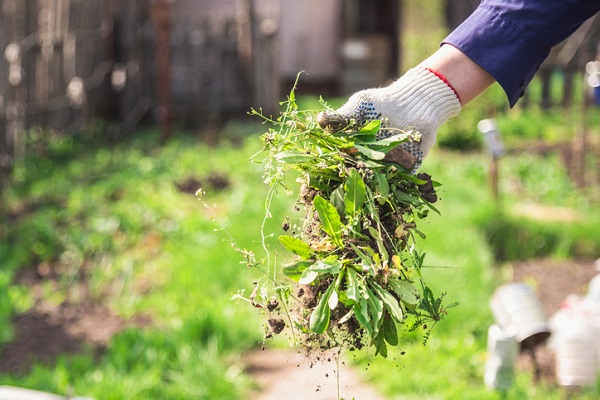If you have a garden, you likely dedicated lots of time to it over the year. To give yourself a head start for next year, it’s important to begin winterizing your garden, before the first frost if possible. We’ll give you five easy ways to start winterizing your garden, along with a bonus tip for raised-bed care!
Eliminate Weeds Early
It’s tempting to hope that the cold will kill off weeds for you. But you’ll be in a much better spot if you eliminate weeds yourself before it gets too cold.
Identify and pull all weeds from anywhere they appear, in or around your garden. Doing so protects next year’s garden and soil against three major problems.
- Additional proliferation. Allowing weeds to stick around throughout winter gives them a better chance of going to seed and rooting down deeper. That means extra weeding in the spring and summer. Additionally, because there’s less competition, weeds can grow like, well, a weed. Nip this problem in the bud and give yourself a fresh start next spring by pulling weeds before the first frost.
- Pest reduction. The longer weeds stick around, the more likely it is that pests will use them as shelter and places to lay eggs.
- Pathogen reduction. Like pests, weeds can become a cesspool for plant-damaging pathogens.
Remove Annuals and Respace Perennials
Another temptation you may face as a gardener is letting your perennial plants (marigolds, tomatoes, radishes) die and decompose naturally. Resist this temptation.
Annuals will die in the winter, and they simply won’t come back. Worse, annuals can harbor pests and pathogens, just like weeds. By leaving them in to essentially rot, you’re putting your garden at a disadvantage.
Once your annuals begin to die (drying out, not producing flowers or fruit), dig them up and throw them away. Generally, you don’t want to compost these plants, since they can transfer pests and disease to your compost.
On the other hand, you can leave perennials (dahlias, hydrangeas) in the ground. However, if you notice that your perennials have grown a little closer together than you want, gently dig a few up and give them proper spacing.
For bulb perennials, you can gently separate the roots from the parent bulb and replant them. This can help your garden look fuller in the spring.

Plant Any Hardy Bulbs You Have
Speaking of bulbs, you should be planting spring bulbs in the fall, ideally before the first frost. A big benefit of planting your hardier bulbs before frost is that the soil will be easier to dig into. Additionally, as the soil hardens in the winter, it can protect your bulbs, especially if you add mulch after you plant (more on this next).
Add Mulch or Rakings on Top of Your Garden Soil
One of the best ways to give your garden a head start for spring is to mulch. After weeding and debris cleaning, adding a layer of mulch in your garden bed can provide many benefits.
- Crowds out lingering weeds and seeds
- Adds organic matter and nutrients
- Keeps the ground cold throughout winter (which is good!)
Lots of gardeners first think that mulch will keep their plants warm. On the contrary, it helps keep the ground frozen throughout winter. That’s a good thing because it can prevent plants from prematurely thawing and growing at the wrong time.
If mulch is too pricey, consider using leaves you rake, along with grass clippings. However, be careful about using debris from annuals or diseased leaves, such as leaves with powdery mildew. You don’t want to transfer pests or pathogens!
Water Once More, Then Turn Watering Systems Off
Once you’ve weeded, cleaned up, and mulched, it’s important to give everything one more big drink of water before the winter.
This is especially important for your trees, perennials, and shrubs. Ideally, you’ll do this a week or two before the ground freezes. This could be anywhere from mid-October to late November.
After giving your perennials, trees, shrubs, and garden their last drink, be sure to drain and turn off any outdoor irrigation systems. You don’t want your pipes to freeze and burst over the winter!
One last tip: Throughout the warmer winter days, don’t be shy about giving trees, perennials, and shrubs water if the conditions are right. If you have a few days where the temperatures will be above freezing in the daytime, that’s a good time to give them some extra water.
Bonus Tip for Raised Garden Beds
If you have raised beds, many of the above tips apply. But as a bonus, double-check the actual structure of your raised bed. Weather, animals, and elements can cause damage to the bed’s structure. If you catch it early, you can repair it before spring.

While You Protect Your Garden, Let 2-10 Protect Your Home
2-10 Home Buyers Warranty offers money-saving systems and appliances coverage against routine breakdowns. That’s important because breakdowns can be expensive!
With a 2-10 Home Service Plan, you can protect more and pay less to address expensive, inconvenient breakdowns.
When you choose 2-10, you can personalize your plan with options that fit your needs and budget. You also get exclusive perks, such as discounts on GE and Whirlpool brand appliances.
While you protect your garden, let 2-10 protect your home.









